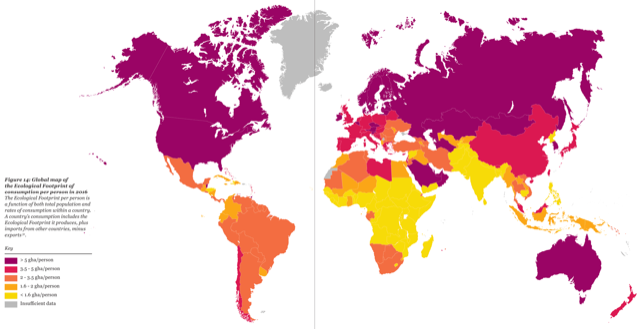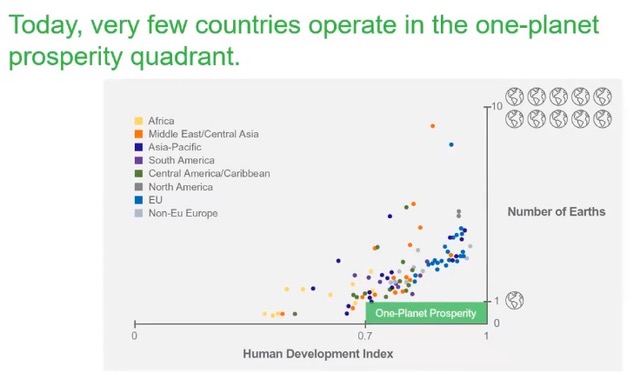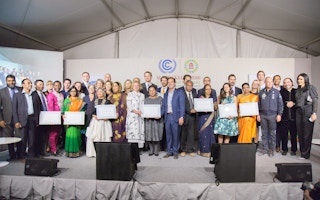To this crucial question as we emerge from the pandemic let’s remind ourselves first of three incontrovertible facts that we must take into account, then derive some principles and criteria, before examining a few candidates.
The climate change threat is dire
“We face the collapse of everything,” says Sir David Attenborough. To which Sir David King, the UK government’s former chief scientist adds:
“We are on course to a 3-4 degree Celsius rise by the end of the century, and more after that. [This] would give rise to unmanageable risks, and yet is the most likely outcome by 2100. The actions in place and the commitments made to date do not match up to the level of seriousness of the implications for the future of humanity.”
He says less than 10 years remain to take necessary action.
Humanity is waging a “senseless and suicidal” war on nature, and it’s costing 10 per cent of annual GDP
These are the words of the UN secretary-general, António Guterres, who says this war is already causing human suffering and enormous economic losses while accelerating the destruction of life on Earth.
“More than 70 per cent of ice free land is now under human control and increasingly degraded, affecting the wellbeing of 3.2 billion people and costing over 10 per cent of annual GDP. The mass of human-made infrastructure exceeds all biomass. Humans and domesticated animals make up more than 90 per cent of the mammalian mass on the planet. Our actions threaten about 1 million species, one in eight, with extinction.”
The evidence is in the UN Environment Programme (UNEP)’s just-published blueprint for “the sustainable world we need” – “Making Peace With Nature”.
No country on earth meets its citizens’ needs sustainably
The evidence is here. Several of the limits of the Earth’s ecosystems to sustain life are already exceeded.
Within these nine scientifically defined planetary boundaries we must learn to satisfy the basic human needs of 8.5 billion people.
The ecological footprints of all but the poorest nations in the world exceed this capacity. If everyone in the world were to live like average Americans we would need seven planet Earths.
Meaning, that there is a strong correlation between wealth (consumption) and ecological footprint.

Ecological footprint by country. Image: WWF

The triple emergency
“We have got a triple emergency and these three issues are all interrelated and have to be dealt with together. They’re no longer just environmental issues – they are economic issues, development issues, security issues, social, moral and ethical issues,” says Prof Sir Robert Watson, who is a lead author of the above report.
Conclusions
Several conclusions follow from these facts:
- Action taken must be urgent and preferably have immediate effects.
- Action must not be at the expense of the poor majority.
- The average level of consumption must be reduced.
- The way we produce things must change to reduce the impacts.
- We must protect and enhance nature and natural ecosystems.
- Action must be holistic: it’s no good taking positive action in one sphere of life and continuing with counter-productive negative actions in another or we will just be standing still at the very best.
It follows that “business as usual” is untenable: that is, business models based on unlimited growth, pollution and destruction of nature without replenishing it must end.
Five criteria
These conclusions imply at least five general criteria for strategies that have a chance of addressing the triple emergency:
1. Contraction and convergence
One strategy which builds on these principles is contraction and convergence. In this process, long-term goals are set to reduce the ecological footprint, with milestones along the way.
Carbon and other green taxes are used to channel funding from polluters to where it is needed. Some of this funding is used to protect the poor.
Hence there is a convergence of consumption levels between the richest and the poorest so that the latter can meet their essential needs (defined by the Sustainable Development Goals).
2. Finance must be targeted at proven solutions
There is only so much investment possible in the world. We want to have the greatest effect in the shortest possible time. It follows that solutions which are proven should receive more investment.
Those which are unproven will not only divert investment away from these but take more time to achieve results, if they ever do. Nuclear fusion is an example of an unproved technology that keeps calling on available finance.
3. Take into account the whole picture
We must account for the entire ecological footprint of proposed solutions in order to capture most benefits and avoid negativities.
This includes impacts from travel, supply chains and procurement, waste and water; and from the use of any goods and services provided.
And, besides greenhouse gas emissions, assess plastic, pollution, and the effect of actions on biodiversity, soil, water and land.
4. Change the economic system
“Of all the things we have to do, we have to really rethink our economic and financial systems. Fundamentally, GDP doesn’t take nature into account. We need to get rid of these perverse subsidies for polluting the earth – they are US$5-7 trillion a year,” says Professor Sir Robert Watson.
It’s because nature has been left off the balance sheet that we have arrived in this dire situation where our existential survival is threatened, as this recent landmark economic report makes clear.
This means taking on companies and countries with vested interests in fossil fuels, Watson says: “There are a lot of people that really like these perverse subsidies. They love the status quo. So, governments have to have the guts to act”.
Financial institutions could end funding for fossil fuels, the razing of forests and large-scale monoculture agriculture. Companies should act too, he says.
5. Social justice must be served
Poor people suffer much more the consequences of climate adversity and loss of nature than the rich. Millions are already affected by extreme weather events in places like Indonesia and Bangladesh.
There are plenty of people needing help both within which societies and in poor countries, and in those industries threatened by the transition to the clean economy. Therefore, there is a moral imperative for a just transition to the green economy.
What solutions?
Applying these criteria, these solutions become prime contenders:
- Introduce a carbon tax, and remove subsidies from polluting activities. These are clear priorities to stop making the problems worse.
- Invest in activities that encourage resource efficiency, energy efficiency, and a circular approach to resource use should be prime candidates. This will help us achieve more with less in order to fairly satisfy the needs of more people with fewer resources.
- Deploying renewable energy at scale should then be the next step.
- Technologies that replace existing unsustainable materials such as concrete with sustainable alternatives should next receive attention.
Some of Bill Gates’ solutions, outlined in his new book, do satisfy these criteria: we do need to find sustainable versions of kerosene jet fuel, steel and concrete.
We do need to electrify energy and provide green hydrogen, “deploying renewables quickly wherever it’s economical to do so,” as he says.
But by applying only his criteria of lowering the “Green Premium” to the search for solutions Gates and others like him fail to meet many of the other criteria, missing out the negative impact of solutions on nature (such as mining) and people (social justice), and failing to recognise the urgency of the situation.
For example, Gates is backing geo-engineering: releasing aerosols high into the atmosphere in order to block the sun’s rays.
Geo-engineering is inherently dangerous since we have no idea what will happen when we interfere with the environment on this scale. What will happen when these particles fall to earth?
What is its lifecycle environmental impact?
The carbon cost of the development of such a problematic technology (manufacturing calcium carbonate particles and sending them to the upper atmosphere) over an unknown period of time with an unknown outcome, will be high.
No to biomass, nuclear power and carbon capture
These are examples of technologies that do not meet the criteria.
We already know that burning biomass such as wood for energy is no longer considered renewable/sustainable because its life-cycle emissions and environmental damage exceed the benefits.
Therefore, subsidies should be removed from it as soon as possible, as with fossil fuels.
In this interview promoting his new book, Gates says of the Green New Deal promoted by Alexandria Ocasio-Cortez who thinks we can be carbon neutral in a decade: “it’s a fairytale. It’s like saying vaccines don’t work – that’s a form of science denialism. Why peddle fantasies to people?”
Instead, he’s “ putting money into carbon capture and nuclear fission.”
There are many problems with nuclear power, which include:
- It takes decades to develop, and we don’t have time [This link details other problems with TerraPower’s proposed technology of which Gates is founder and chairman suports]
- It is far too expensive and diverts investment from more successful alternatives
- We still don’t know what to do with nuclear waste
- Its full carbon footprint is between 10 to 18 times greater than renewable energy technologies.
Carbon capture and storage is also too expensive to achieve fast take-up, not proven, a long way off successful deployment, and diverts investment from more successful alternatives.
Try picking your own solutions and applying the above criteria. Let us know what you find.
This story was published with permission from The Fifth Estate.








